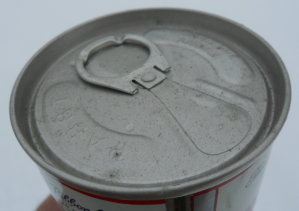| |
HISTORY OF THE BEER CAN  The leading can company that was in pursuit of making the perfect beer can was the American Can Company with the Continental Can Company not far behind. In 1931 both Anheuser-Bush and Pabst Brewery was experimenting with the beer cans but it appeared at that time to costly. The first beer can that was tested to the public happen on January 24, 1935. The Gottfried - Krueger Brewing Company from Newark, New Jersey canned Krueger's Finest Beer and Krueger's Cream Ale. Both brands were in a flat top cans and was tested in the city of Richmond, Va. Within nine months the Gottfried - Krueger Brewing Company sold five and one half times more beer then they were selling in January. By 1935 Pabst of Milwaukee went ahead with plans to put their beer in a blue and silver flat top can. By August 1935 the brewery was filling 24,000 cans of beer daily and selling out in all the test markets.  .Photo courtey of ebay...........................Can opener
directions. .Photo courtey of ebay...........................Can opener
directions. Ad from 1937. Ad from 1937.These flat top beer cans needed a way to be opened. The can opener or church key which it was known to beer drinkers was invented by D. F. Sampson. He is created with the design of the can opener for these flat top beer cans. One end of the opener would cut a triangular hole in the top of the can. The other side would open crown caps. Many of the early beer cans had directions on back of the can on how to use the opener. The American Can Company licensed the rights to this can opener. The company became very successful with their openers. By the end of 1935 about 35 million can openers were on the market. Many brewery names and logos were stamp onto them. In the early days of the flat top cans there would be a can opener in every case of canned beer that was sold. By September 1935 Schlitz Brewing Company would start canning their Lager Beer in a cone top style can. The Continental Can Company produced a low spout top with depressed reinforced "ribs" to the slope and had flat bottoms. The company made these cans for about a year until they changed the design to a raised ribs and a concave bottom in the middle of 1936.  Ad from 1936. Ad from 1936. ....... ....... . Ribs . RibsThese cans used a crown cap closure for their cone top cans. Many smaller breweries used these cone top cans. They could use some of the same capping equipment which made it more cost effective for them. On May 31, 1942 The War Protection Board Order M-81 stated all canning of beer for the general public to be stopped due to the government needing steel for the war effort. The government did allow about a billion cans of beer for our armed forces around the world. Around 35 breweries canned beer specifically for the military. These cans had a drab and dark color theme with the words " With Drawn Free Internal Revenue Tax for Exportation. By 1947 the order was lifted and canned beer was being produced for the public again. By the 1950s the flat top can was the can of choice with the cone top fading away from use. By the end of the 1950s a 16 oz. can was introduced. In 1958 the Hawaii Brewing company put out the first aluminum can but it was a failure. By 1960 Coors successfully marketed a 7 oz. all aluminum can. The pull-tab was designed by Ermal Fraze a tool and die designer from Dayton, Ohio. His patent was the biggest technological innovation since the beer can itself. Pittsburgh's Iron City Brewery in March of 1962 was the first to take it to market. By 1965 75% of all cans produced used the pull-tab tops. This great idea had one problem. Within a few years pull-tabs was starting to litter the ground causing a hazard to animals and humans.  By 1969 the beer can was out selling bottled beer. In 1975 the Fall City Brewing Company of Louisville, Ky. was the first American Brewers to use "stay-tabs" that when opened the tab would stay connected to the can . In the mid 1970s and thoughtout the 1980s can collecting became very popular. The breweries across the country would produce new beers with new graffic on thier cans. You could say it was the begining of the rebirth of these Micro Breweries.   References: AB&GC August 2004-September 2004 Articles by Gary Guest. Frank & Frank Jr. (Wicker) Can Collection. |
|---|---|